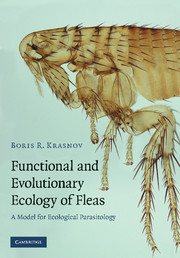Book contents
- Frontmatter
- Contents
- Preface
- Part I Brief descriptive ecology: what do fleas do?
- 1 Composition of the order
- 2 Hosts of Siphonaptera
- 3 Geographical distribution of fleas
- 4 Origin and evolution of fleas
- 5 Life cycles
- 6 Fleas and humanity
- Part II Functional ecology: how do fleas do what they do?
- Part III Evolutionary ecology: why do fleas do what they do?
- References
- Index
3 - Geographical distribution of fleas
Published online by Cambridge University Press: 14 August 2009
- Frontmatter
- Contents
- Preface
- Part I Brief descriptive ecology: what do fleas do?
- 1 Composition of the order
- 2 Hosts of Siphonaptera
- 3 Geographical distribution of fleas
- 4 Origin and evolution of fleas
- 5 Life cycles
- 6 Fleas and humanity
- Part II Functional ecology: how do fleas do what they do?
- Part III Evolutionary ecology: why do fleas do what they do?
- References
- Index
Summary
Geographical range is an immanent feature of every recent or extinct species. Two main characteristics of a geographical range of a species are its position and its size. Many important ecological and evolutionary questions involve these two parameters. What determines the limits of species occurrences? What are the causes of variation in the size of geographical range among and within taxa? How are position and size of geographical ranges related? Is the size of geographical range heritable, i.e. are geographical ranges of sister species similar in size? Do fluctuations in the abundance of a species affect its geographical range? Is the degree of specialization associated with the position and size of geographical range? Basic knowledge on geographical distribution of a taxon of interest is necessary for answering these questions.
Fleas are distributed around the world, although they most probably were introduced by humans and their pets and livestock to some oceanic islands. Therefore, these insects would be a very convenient model for biogeographical studies. Some examples of such studies will be presented later in this book. In this chapter, I focus on taxonomically related patterns of distribution of fleas around the world, variation in the size of geographical range of fleas, and on the relationship between geographical range of a flea and that of its host(s).
General patterns of geographical distribution
Fleas are found on all continents and on most oceanic islands. They even inhabit Antarctica where the endemic Glaciopsyllus antarcticus occurs on a number of seabird species (e.g. Bell et al., 1988; Steele et al., 1997).
- Type
- Chapter
- Information
- Functional and Evolutionary Ecology of FleasA Model for Ecological Parasitology, pp. 18 - 28Publisher: Cambridge University PressPrint publication year: 2008



